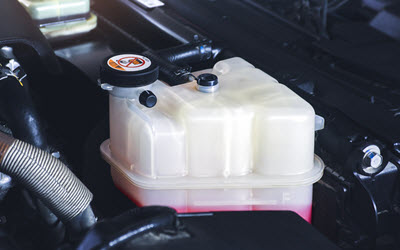Jaguars are the epitome of luxury and performance on four wheels. But like any other vehicle, they aren’t immune to issues. One of the common problems Jaguar owners may encounter is coolant reservoir failure. A malfunctioning coolant reservoir can lead to engine overheating and serious damage if not addressed promptly. Let’s walk through some essential tips to spot coolant reservoir failure in your Jaguar, ensuring your beloved ride stays in pristine condition.
Keep an Eye on the Coolant Level
The first and most obvious sign of coolant reservoir failure is a declining coolant level. Your Jaguar’s coolant reservoir is designed to hold a specific amount of coolant fluid. If you notice that the coolant level is consistently dropping, it’s a clear indicator that something is amiss. But, before you jump to conclusions, it’s crucial to understand why this could be happening.
Coolant loss could be attributed to several factors, including leaks in the cooling system, a damaged radiator cap, or, indeed, a failing reservoir. To pinpoint the exact issue, regularly inspect your coolant reservoir and its surroundings for visible signs of leakage. If you notice a pool of coolant beneath your car or any wet spots around the reservoir, it’s time to investigate further.
Check for Cracks and Damage
Inspecting the physical condition of your Jaguar’s coolant reservoir is a crucial step in identifying potential failures. Over time, the plastic material of the reservoir can deteriorate due to heat, pressure, and age. As a result, cracks or damage may develop, allowing coolant to escape.
To conduct this inspection, start by visually examining the reservoir. Look for any visible cracks, bulges, or discoloration. These are strong indicators of a failing reservoir. Additionally, run your fingers along the surface to feel for any irregularities. A damaged reservoir may feel brittle or have soft spots. If you detect any of these issues, it’s best to replace the reservoir promptly to prevent further damage to your Jaguar’s engine.
Monitor Coolant Temperature
Your Jaguar’s engine operates optimally within a specific temperature range, and the cooling system plays a vital role in maintaining this balance. If your coolant reservoir is failing, it can lead to overheating issues, which can have severe consequences for your vehicle’s engine.
Keep a close eye on your Jaguar’s temperature gauge while driving. If you notice the needle consistently rising towards the red zone or if you receive an overheating warning, it’s a clear sign that the coolant system is struggling. In such cases, it’s imperative to pull over immediately, turn off the engine, and let it cool down. Continuing to drive with an overheating engine can cause irreparable damage.
Once your Jaguar has cooled down, check the coolant reservoir for any visible issues, including coolant leaks or damage. If you suspect a failing reservoir, it’s best to have it replaced by a certified Jaguar technician to ensure the problem is resolved effectively.
Pay Attention to Warning Lights
Modern Jaguars are equipped with advanced diagnostic systems that can detect various issues, including problems with the coolant system. If your dashboard suddenly illuminates with warning lights related to engine temperature or coolant levels, it’s a clear indication that something is amiss.
When these warning lights appear, it’s crucial not to ignore them. Continuing to drive without addressing the issue can lead to severe engine damage. Instead, pull over safely and consult your owner’s manual to understand the specific warning. In many cases, these warnings will prompt you to check the coolant level or the engine temperature. Use these warnings as a cue to inspect your coolant reservoir and cooling system for any visible problems.
Your Jaguar is a work of art and engineering, deserving the utmost care and attention. Recognizing the signs of coolant reservoir failure is essential to maintaining the performance and longevity of your prized vehicle. By regularly monitoring the coolant level, inspecting for cracks or damage, keeping an eye on the temperature gauge, and heeding warning lights, you can catch coolant reservoir issues early and prevent potential engine damage.
Experience Excellence with Auto Assets
When it comes to maintaining and servicing your Jaguar,  trust the experts at Auto Assets. Auto Assets is your premier destination for Jaguar maintenance and repairs. Our experienced technicians are well-versed in the intricacies of Jaguar vehicles, ensuring that your luxury car receives the care it deserves.
trust the experts at Auto Assets. Auto Assets is your premier destination for Jaguar maintenance and repairs. Our experienced technicians are well-versed in the intricacies of Jaguar vehicles, ensuring that your luxury car receives the care it deserves.
Don’t wait until coolant reservoir failure causes irreversible damage to your Jaguar. Take action today and entrust your vehicle to the skilled professionals at Auto Assets. We are conveniently located in Columbus, Dublin, New Albany, Worthington, and Powell, OH. Your luxury ride deserves nothing but the best. Schedule your service with us today!
* White Jaguar F-Pace SUV image credit goes to: Artistic Operations.
 356 W Olentangy St, Powell, OH 43065, United States
356 W Olentangy St, Powell, OH 43065, United States 614-793-1050
614-793-1050 Weekdays 8am to 6pm, Saturday 9am to 4pm, Closed Sunday
Weekdays 8am to 6pm, Saturday 9am to 4pm, Closed Sunday 356 W Olentangy St, Powell, OH 43065
356 W Olentangy St, Powell, OH 43065





